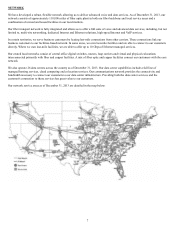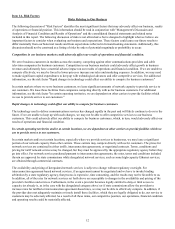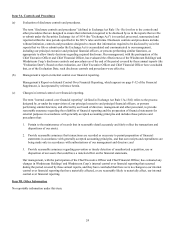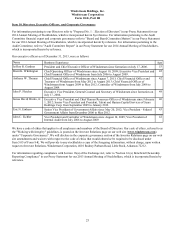Windstream 2013 Annual Report Download - page 115
Download and view the complete annual report
Please find page 115 of the 2013 Windstream annual report below. You can navigate through the pages in the report by either clicking on the pages listed below, or by using the keyword search tool below to find specific information within the annual report.
17
If we are prohibited from participating in government programs, our results of operations could be materially and adversely
affected.
We are the recipient of a material amount of end user revenue and government subsidies under various government programs
and also serve as a government contractor for services for various state, local and federal agencies. Our failure to comply with
the complex government regulations and statutes applicable to the programs, or the terms of one or more of our government
contracts, could result in our being suspended or disbarred from future government programs for a significant period of time or
result in harm to our reputation with the government and possible restriction from future government activities. While we have
implemented compliance programs and internal controls that are reasonably designed to prevent misconduct and non-
compliance relating to the government programs and contracting, we cannot eliminate the risk that our employees, partners or
subcontractors may independently engage in such activities.
If we are suspended or debarred from government programs, or if our government contracts are terminated for any reason, we
could suffer a significant reduction in expected revenue which could have a material and adverse effect on our operating
results.
New technologies may affect our ability to compete in our consumer markets.
Wireless companies are aggressively developing networks using next-generation data technologies, which are capable of
delivering high-speed Internet service via wireless technology to a large geographic footprint. If these technologies continue to
expand in availability and reliability, they could become an effective alternative to our high-speed Internet services. In addition,
cable operators may be able to take advantage of certain technology to deploy faster broadband speeds more rapidly than
Windstream.
In addition to broadband technology, evolving voice technologies, such as Voice over Internet Protocol ("VoIP"), may
effectively compete with voice and long-distance services in our consumer markets.
These and other new and evolving technologies could result in greater competition for our voice and high-speed Internet
services. If we cannot develop new services and products to keep pace with technological advances, or if such services and
products are not widely embraced by our customers, our results of operations could be adversely affected.
Competitors, especially cable television companies, in our consumer markets are subject to less stringent industry
regulations, which could result in voice line and revenues losses in the future.
Cable television companies are generally subject to less stringent regulations than our consumer operations. Cable voice
offerings and others are subject to fewer service quality and reporting requirements than our consumer operations, and their
rates are generally not subject to regulation, unlike our consumer voice services. Our consumer areas are also subject to "carrier
of last resort" obligations, which generally obligate us to provide basic voice services to any person within our service area
regardless of the profitability of the customer. Our competitors in these areas are not subject to such requirements.
Because of these regulatory disparities, we have less flexibility in our consumer markets than our competitors. This could result
in accelerated voice line and revenue losses in the future.
Different interpretation and/or implementation of certain sections contained in the FCC’s Intercarrier Compensation and
Universal Service reform order could result in additional access revenue reductions.
The FCC's reform order adopted in 2011 provides that intrastate traffic that originates in VoIP format and is delivered by long
distance carriers to us for termination will be assessed interstate access charges. During 2012, we coordinated with long
distance carriers to transition to these reduced interstate access rates, and this transition resulted in further reductions on July 2,
2013.
In a subsequent order, the FCC determined that intrastate traffic we originate through the traditional telephone network and
deliver to a customer served under a VoIP platform is subject to interstate access charges beginning on July 1, 2014. We have
filed an appeal in the United States Court of Appeals for the 10th Circuit asserting that the FCC's decision to cut originating
access for such traffic without establishing a mechanism for recovering lost revenues was arbitrary, capricious, and/or
inconsistent with reasoned decision making. If our appeal fails or the FCC fails to create a recovery mechanism, we will incur
additional access revenue reductions. In addition, due to the uncertainty surrounding the application of these rules, we cannot
























